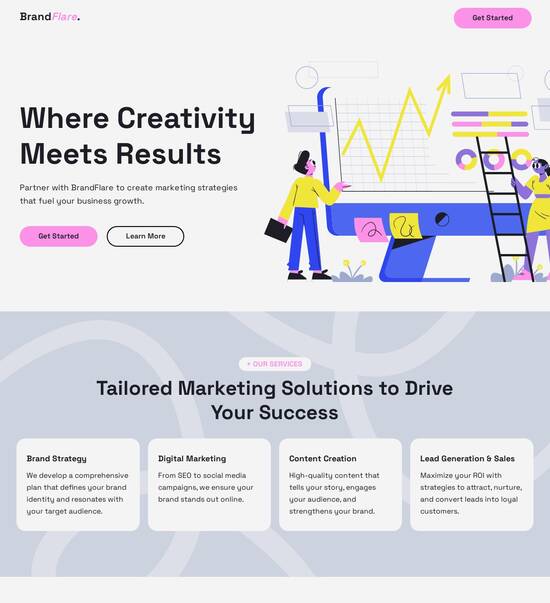
Website template for collaborations
Explore Similar TemplatesAbout template
Take advantage of Instapage's website template for collaborations
Recommended templates

Easy to build without coding
With the intuitive drag-and-drop builder, anyone on your team can create high-converting pages without any knowledge of code or design. Make enhancements to your landing page with custom widgets using Javascript, HTML/CSS, or third-party scripts.

Multiple layouts for any industry and goal
Select from 500+ landing page layouts built to boost conversions across industry-specific scenarios. Customize them by adjusting fonts, adding images, and generating on-brand content with the AI assistant. Quickly scale with Instablocks® and Global Blocks that you can save, reuse, and update globally.

Loads fast and looks polished on any device
Every template is responsive, which means they present professionally on any device and load blazingly fast with our Thor Render Engine. You can also power them up with Google AMP technology to deliver an unparalleled mobile experience and drive higher conversions.

Robust analytics & experimentation
Get real-time updates and reporting across all your devices, showing the number of visitors, conversions, cost-per-visitor, and cost-per-lead. Launch AI-powered experiments, run A/B tests, and use heatmaps to analyze user behavior, then optimize your landing page to maximize conversions.







Easy to build without coding
With the intuitive drag-and-drop builder, anyone on your team can create high-converting pages without any knowledge of code or design. Make enhancements to your landing page with custom widgets using Javascript, HTML/CSS, or third-party scripts.
Multiple layouts for any industry and goal
Select from 500+ landing page layouts built to boost conversions across industry-specific scenarios. Customize them by adjusting fonts, adding images, and generating on-brand content with the AI assistant. Quickly scale with Instablocks® and Global Blocks that you can save, reuse, and update globally.
Loads fast and looks polished on any device
Every template is responsive, which means they present professionally on any device and load blazingly fast with our Thor Render Engine.
Robust analytics & experimentation
Get real-time updates and reporting across all your devices, showing the number of visitors, conversions, cost-per-visitor, and cost-per-lead. Launch AI-powered experiments, run A/B tests, and use heatmaps to analyze user behavior, then optimize your landing page to maximize conversions.
All the features you need to build instapage
Explore more featuresLearn how to build top-performing landing pages for any goal
FAQs
Leading the way in building high-performing landing pages





A comprehensive guide to instapage for landing page optimization
Instapage is your go-to solution for creating high-converting landing pages that maximize ROI on your digital marketing campaigns. With its robust collection of templates and powerful tools, marketers across various sectors—from tech to healthcare—can streamline their campaigns and drive lead conversions effectively.
Understanding instapage's core features
To harness the full potential of Instapage, it’s essential to understand its key features. These elements collectively enhance the user experience and facilitate optimal conversion rates at various stages of the customer journey. Instapage offers intuitive drag-and-drop builders, sophisticated A/B testing functionalities, and seamless integrations with popular marketing tools.
- Over 100 customizable templates: Easily create landing pages that align with your brand’s identity without starting from scratch. These templates are designed based on industry best practices to ensure they convert visitors effectively.
- Built-in A/B testing: Experiment with different versions of your landing pages to identify which design or content resonates best with your audience. This can significantly improve conversion rates over time.
- Comprehensive analytics dashboard: Track your page performance with detailed insights and heatmaps, which reveal how users interact with your content.
Step 1: Creating a landing page in instapage
Getting started with Instapage is straightforward. First, navigate to the dashboard to choose a template from the extensive library available. Consider your campaign goals and select a design that aligns with your target audience's expectations.
- Browse through industry-specific templates: This saves time and ensures that you're drawing inspiration from proven designs best suited for your vertical.
- Customize your landing page: Utilize the drag-and-drop functionality to adjust elements according to your preferences, adding images, videos, or forms as needed.
- Preview your page: Before publishing, always check how your landing page looks on different devices to ensure an optimal user experience.
Step 2: Optimizing for conversions
Once your landing page is live, the next crucial step is optimization. Use Instapage’s built-in tools to maximize engagement and encourage action.
- Implement A/B testing: Use different headlines, call-to-action buttons, or images to determine what influences your visitors the most positively.
- Use dynamic text replacement: This feature allows you to tailor your landing pages instantaneously based on the source that brought the traffic, enhancing relevance for your visitors.
- Analyze with heatmaps: Regularly check heatmaps available in your analytics dashboard to track user engagement and adjust your landing pages accordingly.
Step 3: Collaborating and sharing your pages
Finally, collaboration plays a vital role in ensuring your landing pages meet all necessary standards before launch. Use Instapage’s collaboration features to streamline feedback and revisions.
- Share for instant feedback: Share your landing pages with colleagues or stakeholders and provide them the opportunity to give instant feedback or request changes.
- Edit in real-time: Make adjustments based on feedback directly within the platform, ensuring that all updates are captured without multiple versions.
- Secure sharing and permissions: Control who accesses your pages, ensuring that sensitive information is only viewed by those who need it.
By utilizing Instapage's comprehensive features, you empower your marketing team to create, optimize, and collaborate effectively, leading to higher conversion rates and improved campaign performance.
Now is the perfect time to take your landing page strategy to the next level with Instapage. Start creating and optimizing your high-converting landing pages today!
People also ask about Website template for collaborations
Understanding the power of website templates for collaborations
The fundamentals of website templates
Website templates serve as pre-designed layouts that enable users to create functional and visually appealing pages without extensive technical skills. They provide a skeleton for various online projects, making design tasks more manageable and accessible. In collaborative environments, website templates can significantly streamline communication, unify styles, and hasten project timelines, allowing teams to focus on content and functionality rather than design intricacies.
Templates also play a crucial role in maintaining brand consistency across different team outputs. When numerous contributors are involved, having a standardized template helps ensure that every piece of work aligns with the brand’s visual identity and messaging. This cohesion is particularly advantageous in collaborative projects where multiple parties may not be familiar with each other's work styles or preferences.
Static templates: These templates provide a fixed layout without interactive elements, suitable for simple presentations.
Dynamic templates: These offer adaptable layouts that can change based on user interaction, making them ideal for collaboration.
Responsive design: Templates created with responsive design principles ensure seamless viewing across various devices.
Key features enhancing collaborative website templates
The key features of collaborative website templates greatly enhance teamwork and efficiency. Customizable design elements are pivotal in ensuring that templates can be tailored to the specific needs of a project. Distinct pre-built sections dedicated to teamwork, such as shared calendars, task lists, and collaborative document spaces, allow teams to maintain a focused workflow, eliminating the chaos often associated with team projects.
Customization encourages creativity, as it allows team members to express their ideas while adhering to a unified aesthetic. By enabling team members to modify templates, enhances coherence, and nurtures a sense of ownership over the project. Additionally, integrated collaboration tools further facilitate teamwork. Features such as real-time editing and commenting functionalities mean that feedback can be given on-the-fly, ensuring all voices are included and that no critical input is overlooked.
Real-time editing: Team members can simultaneously work on the same document, reducing bottlenecks.
Commenting features: Enabling team members to leave feedback directly within the template fosters clear communication.
Version control: Keeping track of changes helps avoid confusion and maintains a clear project history.
Technical underpinnings of collaboration
A solid technical foundation is indispensable for effective collaborative website templates. Understanding how functionalities within templates enhance interactive elements is crucial. For instance, using JavaScript functions can allow users to reveal content dynamically based on user input, enriching the collaboration experience. Common functions might include toggling visibility for comments or creating pop-up reminders for deadlines, facilitating smoother team interactions.
Moreover, implementing performance optimization strategies, such as lazy loading through iolazy, significantly improves user experience. Lazy loading defers the loading of non-essential images and content until they are needed, ensuring that the website remains responsive even under high traffic. This is particularly useful in large collaborative projects, where numerous assets are simultaneously at play, preserving the performance of the website throughout the collaboration process.
Event management with document.addEventListener: Utilizing this method allows for responsive interactions.
Maximizing user experience with DOMContentLoaded ensures all essential elements are ready for interaction, aiding collaboration.
Employing various functions within templates sharpens interactions and retains engagement.
Tailoring templates for diverse team needs
Recognizing that different teams have unique requirements is vital when selecting or designing website templates for collaboration. For creative teams, such as designers and writers, templates often need to prioritize aesthetic appeal and visual features that allow for creative expression. Therefore, templates equipped with extensive image galleries or typography options are crucial for these groups. In contrast, corporate teams in settings like marketing or HR may require templates focused on data presentation, analytics, and project tracking options to meet their operational goals.
Additionally, the configuration of user roles and permissions is essential for maintaining order within collaborative projects. By setting up specific access levels, team leaders can ensure that members can only edit relevant parts of a project. This prevents unauthorized changes and enhances accountability among team members. Tailored permissions help clarify responsibilities and can also speed up the review process, as everyone knows their defined role within the project framework.
Creative teams: Need flexibility in design and numerous customizable options.
Corporate teams: Require efficient data management and presentation features.
User roles: Establishing clear access levels fosters accountability and project clarity.
Practical applications of collaboration-focused templates
Case studies from different sectors demonstrate the success of collaboration-centered website templates. For instance, an education institution utilized collaborative templates to enhance curriculum development among faculty, leading to enriched course content and more cohesive teaching strategies. Insights collected showed a remarkable increase in both faculty satisfaction and student learning outcomes after template adoption, highlighting the benefits of collaborative structures.
Additionally, integrating third-party tools, such as Slack for communication or Trello for task management, can augment the efficacy of these templates. These integrations allow teams to streamline their workflow, maintaining all necessary tools within one platform. While there may be challenges regarding compatibility and data transfer, the long-term benefits often outweigh these initial hurdles, resulting in improved efficiency and team satisfaction.
Case Study: Educational institution improves curriculum development via collaborative templates.
Integration of tools like Slack and Trello enhances overall team efficiency.
Outcome measurements show significant improvements in team productivity.
The future of website templates for teams
As the landscape of collaboration evolves, so too must website templates adapt to meet emerging needs. Anticipated advancements in the realm of design and functionality include improved artificial intelligence applications that can modify templates based on user preferences and behavior. Imagine templates that learn from user interactions to suggest improvements, thereby maximizing efficiency and engagement. This is not merely a fantasy but a burgeoning reality as AI technology continues to integrate into web development.
Preparing for the future also entails identifying essential features that will support effective collaboration. Teams should consider incorporating tools for analytics and performance tracking into their templates from the outset. These can help assess interaction rates and identify areas needing adjustment. Equipping teams with a robust feedback mechanism allows for continuous improvement, which is key in a fast-paced collaborative environment.
Emerging trends: AI-powered templates that adapt based on usage.
Essential features: Analytics and performance tracking to enhance user interactions.
Strategies for improvement: Continuous feedback loops foster adaptation.
Crafting an engaging user experience in collaborative templates
Designing collaborative templates with a user-centered approach is critical for team satisfaction and productivity. Empathy in design ensures that the needs of all team members are met, creating a more inclusive environment. Techniques such as conducting user persona research help identify key features that will serve different roles within a team, ensuring that everyone has their needs addressed within the template’s design.
Additionally, employing feedback loops can foster ongoing template evolution. By implementing mechanisms through which team members can offer suggestions or report issues, teams can continuously iterate on the design. Real-world examples demonstrate how this feedback method has led to improved usability and satisfaction in past projects, indicating that embracing the voices of users is essential for effective collaborative web design.
User-centered design principles: Focus on empathy to address diverse needs.
Feedback loops: Continuous improvement through user suggestions.
Real-world examples: Successful projects illustrate the importance of user input.
Overcoming challenges in collaborative template design
Despite the advantages of collaboration-focused website templates, potential pitfalls will often arise. Identifying common challenges, such as miscommunication or lack of clarity around roles, can help preemptively address issues before they escalate. Establishing clear guidelines and regularly communicating updates ensures that everyone on the team is on the same page, significantly reducing misunderstandings amidst collaboration.
Case studies of successful projects often highlight how organizations turned potential collaboration hurdles into triumphs. For instance, some teams have implemented structured check-ins and milestone tracking to maintain focus and accountability. Lessons learned from previous challenges can equip teams with strategies for their collaborations moving forward, underscoring the importance of having systems in place to manage team dynamics effectively.
Common pitfalls: Miscommunication and lack of clarity in roles.
Proactive approaches: Regular communication fosters team alignment.
Lessons learned: Strategies that transformed challenges into successes.
Building a culture of collaboration through template use
Cultivating a culture of collaboration is essential for maximizing the potential of website templates. Various cultural factors influence how effectively a team collaborates, with values such as open communication and mutual respect playing significant roles. Strategies such as promoting team bonding sessions and celebrating collective achievements contribute to fostering a collaborative mindset that will enhance productivity.
Additionally, ongoing training and development are crucial for template proficiency. Upskilling team members on the use of templates ensures that everyone can leverage collaborative features effectively. Training opportunities can include workshops or creating resource materials that guide users through template functionalities. When teams are well-versed in using templates, they can collaborate more confidently, leading to better project outcomes.
Cultural factors: Open communication and respect build the foundation of collaboration.
Team bonding: Building relationships enhances collaborative efforts.
Training: Ongoing development fosters confidence and template usage.
Ready to skyrocket conversions?
Supercharge your ad campaigns with high-performing landing pages
Get started














